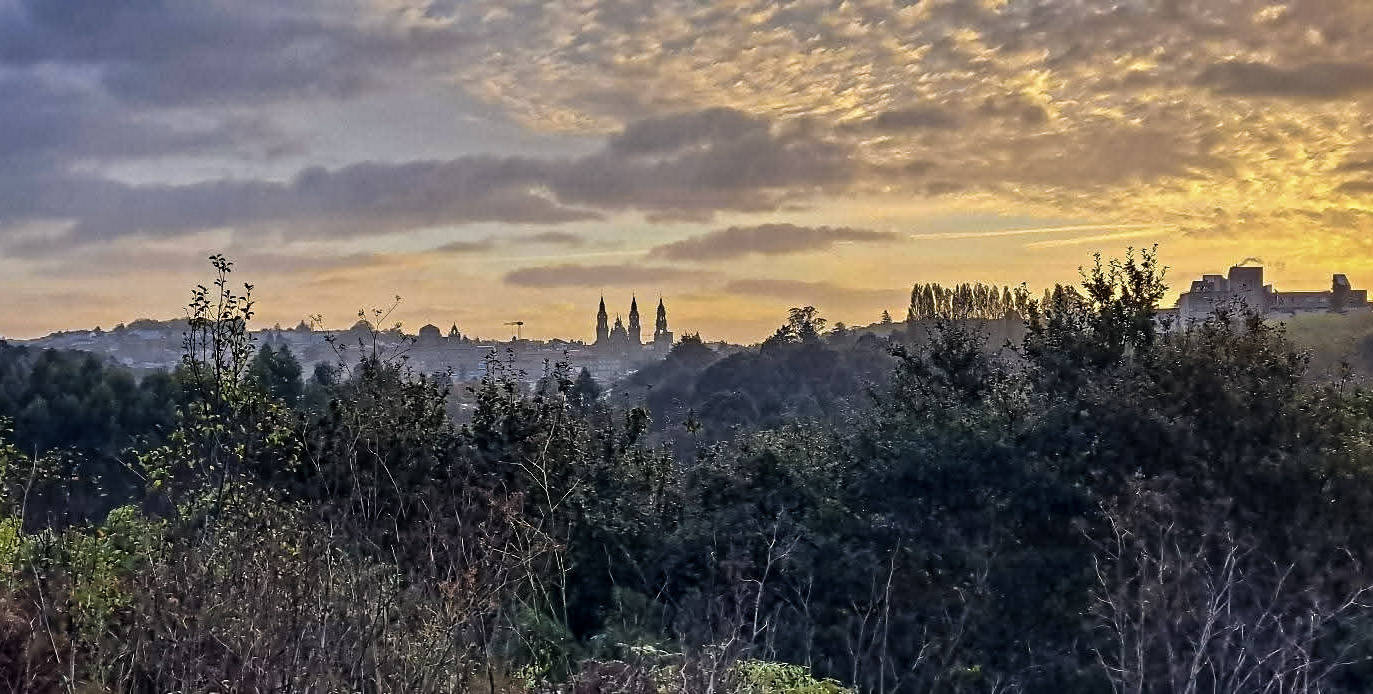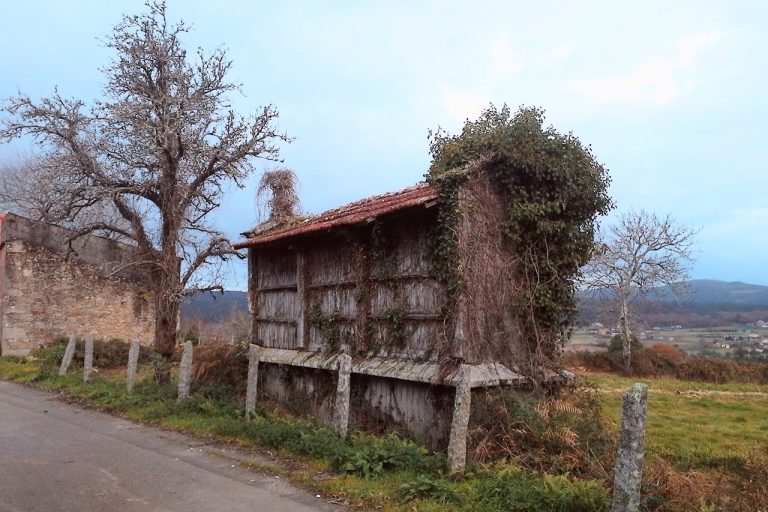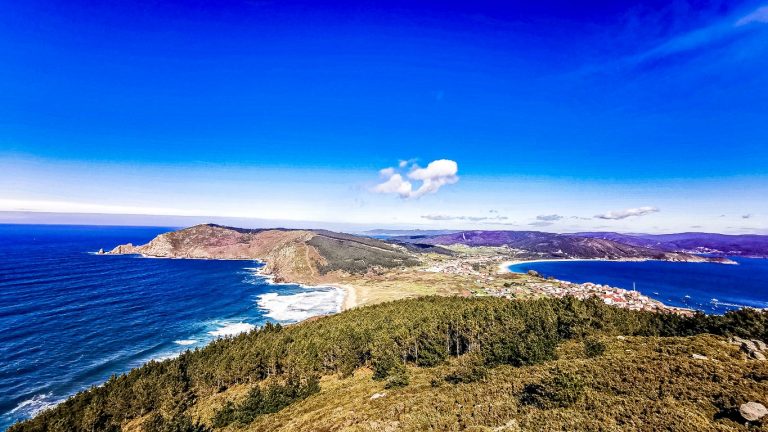
A New Stage Day – Beginning & Mood
Morning in Santiago carries a different kind of light. Between the stone walls of the old town, the incense of the last Mass still lingers, while on the Praza do Obradoiro the bells announce the day. Some pilgrims embrace; others gaze long at the cathedral façade, as if wanting to be sure that the journey is truly over – or perhaps only just beginning.
You start walking, casting one last look back at the towers. The path no longer leads you to the goal, but away from it – out of the sound of the city, into the quiet green of Galicia. This first stage is a passage: from arriving to moving on, from gratitude to letting go.
“Atrás queda el panorama pétreo de la urbe soñadora,” wrote Luciando Huidobro. Behind you remains the city of stone and prayer; before you opens the fertile plain of A Mahía, covered with pines, crossed by clear streams – alive and silent at once.
It is a quiet departure. The asphalt beneath your shoes slowly gives way to earth, and with each step fades the thought that you must still achieve something. The wind knows you have come only to lose yourself a little further.
Route & Elevation Profile
• Distance: approx. 20.6 km
• Elevation: +370 m / –430 m
• Difficulty: easy to moderate
• Duration: approx. 5 h 15 min
• Character: gentle ascents and descents, shaded woods, river valleys, old paths
The route begins on urban pavement, then leads along country roads, forests, and ancient trade paths. No climb is long, yet the alternation between asphalt and soil calls for attention. The greatest challenge lies within: to part from Santiago without losing the feeling of having arrived.









Description of the Way – With All Senses
One last glance at the Cathedral, then the Rúa das Hortas leads you downhill, past the Church of San Fructuoso, whose four statues represent the cardinal virtues. Shortly after, the path opens into the Carballeira de San Lourenzo, an ancient grove of oaks. Here you find the first stone marked with a scallop shell – the beginning of a new section of the Camino.
You cross the River Sarela (Km 1.5) and see, on the opposite bank, the old tanneries overgrown with ivy. Behind Sarela da Baixo (Km 2.3), it’s worth a brief look back: for the last time, the Cathedral appears over the hills.
The trail continues through eucalyptus forests – that scent which will accompany you for many days to come. Soon you reach Moas de Abaixo and Carballal (Km 4.5), where you enter the parish of Villestro. From here, the path rises gently, flanked by ferns, shrubs, and the occasional barking dog whose voice fades in the valley.
At Quintáns (Km 7.1) the view opens over the valley – a short moment of vastness. Then you reach the bridge over the Río Roxos, where shaded picnic tables invite a pause. A little later comes Alto do Vento (Km 8.8), a small pass with a bar and resting area.
The descent leads to Ventosa (parish of Covas) and across the country road AC-453 to Augapesada (Km 11.6). Here begins the most demanding part of the day: the climb along the historic Camino Real to Alto do Mar de Ovellas. About two kilometers, 215 meters of ascent – noticeable, but rewarding. The path runs partly through oak forest, partly along a narrow road. At the top (Km 13.8), a quiet height rewards you with wide views across the land.
Then follows the descent into the parish of Trasmonte de Ames. You pass Carballo (Km 14.2) and Trasmonte (Km 15.0), where a small bar awaits. Then come the hamlets of Reino and Burgueiros, before you reach the Río Tambre.
Here lies Ponte Maceira (Km 17) – the heart of this stage. The medieval bridge from the 14th century, destroyed several times by the river and rebuilt again, arches in graceful sweep over the water. Beside it stand the chapel of San Blas (or del Carmen) and the Pazo de Baladrón. The sound of the river, the stones, the stories – a place where time moves slower.
After the bridge, a short wooded section follows along the river, then the route continues through Barca (Km 19.1) and A Chancela (Km 20.2) toward Negreira. Those who wish can take a small detour to Logrosa, where an albergue and the old Pazo do Capitán stand.
Finally, the view opens onto Negreira (Km 21): the day’s destination. A small town with every service, guesthouses, and that quiet warmth found only in Galicia.
Towns & Highlights
| Town | Distance from Santiago (km) | Highlight | Tip |
| Sarela da Baixo | 2.3 | Last view of the Cathedral | Short photo stop |
| Quintáns | 7.1 | Viewpoint over the Mahía Valley | Water break |
| Augapesada | 11.6 | Start of the Mar de Ovellas climb | Refreshment at Bar-Tienda |
| Trasmonte | 15.0 | Village with hórreos, small bar | Refill water |
| Ponte Maceira | 17.0 | Bridge over the Tambre, Chapel of San Blas | Riverside rest stop |
| Negreira | 20.6 | Historic small town | Stage end, accommodation |
Variants & Small Detours
There are no official variants, but an alternative path follows the Tambre river – a quiet stretch between ferns and chestnut trees, best enjoyed in clear weather. Cycling pilgrims can avoid the steep section at Mar de Ovellas by following the road CP-0204.
Packing & Shopping Tips
• Bars in Roxos, Augapesada, Trasmonte, and Negreira.
• Few shopping options between Augapesada and Negreira – bring provisions.
• Water points in Trasmonte and Ponte Maceira.
• Rain gear is essential – weather can change at any moment.
• Good shoes with grip – slippery after rain.
An apple from Santiago carries you farther than you think.
Food, Lodging & Supplies
In Negreira you’ll find several albergues – municipal, private, and donativo. There are also guesthouses and hotels. Those who prefer to sleep in rural quiet can stay in Logrosa or A Chancela.
The Plaza de España forms the center: bars, small shops, and in the evening the voices of pilgrims sharing stories over a glass of Ribeiro wine.
Negreira itself – seat of the Comarca Barcala – was already a crossroads in Roman times. Later it became a fief of the Church of Santiago and gained independence only under the Catholic Monarchs. Today, the Pazo de Cotón and the Chapel of San Mauro unite history with the present – where, for centuries, the Sunday market has taken place.
Today’s Essence
This stage mirrors the Camino itself – from the stone stillness of Santiago to the soft hills of the Mahía. The Alto do Mar de Ovellas tests the legs, the Ponte Maceira the heart.
Negreira, the “City of the Black Queen,” keeps its legends: once, a noble lady is said to have blocked the way for pilgrims – and yet they found their path. Today the town opens doors, not borders.
Reflection at Day’s End
You have left Santiago – and yet not the Camino. Today was no farewell, but a continuation. Perhaps that is the Camino’s truest lesson: that sometimes it takes more courage to go on after the goal than to reach it.
📊 Stage Overview
| Stage | Start | Destination | Distance (km) | Elevation (+/–) | Difficulty | Key Stops |
| 1 | Santiago de Compostela | Negreira | 20.6 | +370 / –430 | easy–moderate | Roxos, Augapesada, Trasmonte, Ponte Maceira |
🌌 Camino of the Stars
Santiago de Compostela → Sarela da Baixo → Roxos → Augapesada → Trasmonte → Ponte Maceira → Negreira
Did you pause at the bridge of Ponte Maceira – or walk on until the murmur of the Tambre faded? Write that moment down. It already belongs to your next Camino.


